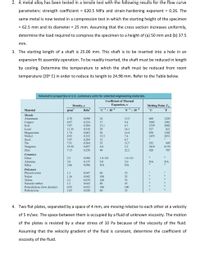
Elements Of Electromagnetics
7th Edition
ISBN: 9780190698614
Author: Sadiku, Matthew N. O.
Publisher: Oxford University Press
expand_more
expand_more
format_list_bulleted
Concept explainers
Question

Transcribed Image Text:2. A metal alloy has been tested in a tensile test with the following results for the flow curve
parameters: strength coefficient = 620.5 MPa and strain-hardening exponent 0.26. The
same metal is now tested in a compression test in which the starting height of the specimen
= 62.5 mm and its diameter = 25 mm. Assuming that the cross section increases uniformly,
determine the load required to compress the specimen to a height of (a) 50 mm and (b) 37.5
mm.
3. The starting length of a shaft is 25.00 mm. This shaft is to be inserted into a hole in an
expansion fit assembly operation. To be readily inserted, the shaft must be reduced in length
by cooling. Determine the temperature to which the shaft must be reduced from room
temperature (20° C) in order to reduce its length to 24.98 mm. Refer to the Table below.
Volumetric properties in U.S. customary units for selected engineering materials.
Coefficient of Thermal
Expansion, a
Density, p
Ib/in
Melting Point, T
Material
g/cm
C'x 10
F'x 10 6
°C
°F
Metals
Aluminum
Copper
Iron
Lead
0.098
0.324
0.284
1220
1981
2802
2.70
24
13.3
660
1083
1539
8.97
17
9.4
7.87
12.1
6.7
11.35
0.410
29
16.1
327
621
Magnesium
Nickel
1.74
8.92
0,063
0.322
26
13.3
14.4
7.4
650
1455
1202
2651
Steel
Tin
7.87
7.31
19.30
0.284
12
6.7
0.264
0.697
23
12.7
232
449
Tungsten
Zinc
4.0
2.2
3410
6170
7.15
0.258
40
22.2
420
787
Ceramics
Glass
2.5
0.090
1.8-9.0
1.0-5.0
0.137
0,096
9.0
5.0
Alumina
Silica
3.8
NA
NA
2.66
NA
NA
Polymers
Phenol resins
1.3
0.047
60
33
Nylon
Teflon
Natural rubber
Polyethylene (low density)
Polystyrene
1.16
0.042
100
55
0.079
0.043
55
2.2
1.2
100
80
45
0.033
0.038
180
100
0.92
1.05
60
33
4. Two flat plates, separated by a space of 4 mm, are moving relative to each other at a velocity
of 5 m/sec. The space between them is occupied by a fluid of unknown viscosity. The motion
of the plates is resisted by a shear stress of 10 Pa because of the viscosity of the fluid.
Assuming that the velocity gradient of the fluid is constant, determine the coefficient of
viscosity of the fluid.
Expert Solution
This question has been solved!
Explore an expertly crafted, step-by-step solution for a thorough understanding of key concepts.
This is a popular solution
Trending nowThis is a popular solution!
Step by stepSolved in 3 steps with 2 images

Knowledge Booster
Learn more about
Need a deep-dive on the concept behind this application? Look no further. Learn more about this topic, mechanical-engineering and related others by exploring similar questions and additional content below.Similar questions
- The brass has a shear modulus (G) of 40 GPa. In the torsion test calculated results, (G) was found to be 37 830 MPa. What is the percentage of errors in the experiment? Select one: a. 0.54% O b. 5.425% c. 0.05425% O d. 3.779%arrow_forward3. A rod-shaped MgO specimen with round cross section is tested with the three-point bend method. What is the calculated minimum radius without fracture if the applied load is 5560 N, the flexural strength is 105 MPa, and the separation between the two support pins is 45 mm?arrow_forward3 please include sketcharrow_forward
arrow_back_ios
arrow_forward_ios
Recommended textbooks for you
 Elements Of ElectromagneticsMechanical EngineeringISBN:9780190698614Author:Sadiku, Matthew N. O.Publisher:Oxford University Press
Elements Of ElectromagneticsMechanical EngineeringISBN:9780190698614Author:Sadiku, Matthew N. O.Publisher:Oxford University Press Mechanics of Materials (10th Edition)Mechanical EngineeringISBN:9780134319650Author:Russell C. HibbelerPublisher:PEARSON
Mechanics of Materials (10th Edition)Mechanical EngineeringISBN:9780134319650Author:Russell C. HibbelerPublisher:PEARSON Thermodynamics: An Engineering ApproachMechanical EngineeringISBN:9781259822674Author:Yunus A. Cengel Dr., Michael A. BolesPublisher:McGraw-Hill Education
Thermodynamics: An Engineering ApproachMechanical EngineeringISBN:9781259822674Author:Yunus A. Cengel Dr., Michael A. BolesPublisher:McGraw-Hill Education Control Systems EngineeringMechanical EngineeringISBN:9781118170519Author:Norman S. NisePublisher:WILEY
Control Systems EngineeringMechanical EngineeringISBN:9781118170519Author:Norman S. NisePublisher:WILEY Mechanics of Materials (MindTap Course List)Mechanical EngineeringISBN:9781337093347Author:Barry J. Goodno, James M. GerePublisher:Cengage Learning
Mechanics of Materials (MindTap Course List)Mechanical EngineeringISBN:9781337093347Author:Barry J. Goodno, James M. GerePublisher:Cengage Learning Engineering Mechanics: StaticsMechanical EngineeringISBN:9781118807330Author:James L. Meriam, L. G. Kraige, J. N. BoltonPublisher:WILEY
Engineering Mechanics: StaticsMechanical EngineeringISBN:9781118807330Author:James L. Meriam, L. G. Kraige, J. N. BoltonPublisher:WILEY

Elements Of Electromagnetics
Mechanical Engineering
ISBN:9780190698614
Author:Sadiku, Matthew N. O.
Publisher:Oxford University Press

Mechanics of Materials (10th Edition)
Mechanical Engineering
ISBN:9780134319650
Author:Russell C. Hibbeler
Publisher:PEARSON

Thermodynamics: An Engineering Approach
Mechanical Engineering
ISBN:9781259822674
Author:Yunus A. Cengel Dr., Michael A. Boles
Publisher:McGraw-Hill Education

Control Systems Engineering
Mechanical Engineering
ISBN:9781118170519
Author:Norman S. Nise
Publisher:WILEY

Mechanics of Materials (MindTap Course List)
Mechanical Engineering
ISBN:9781337093347
Author:Barry J. Goodno, James M. Gere
Publisher:Cengage Learning

Engineering Mechanics: Statics
Mechanical Engineering
ISBN:9781118807330
Author:James L. Meriam, L. G. Kraige, J. N. Bolton
Publisher:WILEY